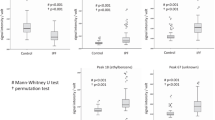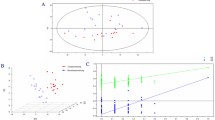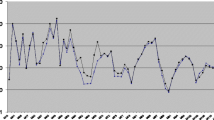Abstract
Exhaled breath of patients suffering non-small bronchial carcinoma contains volatile organic compounds (VOC) different from healthy people. VOCs could be detected using ion mobility spectrometry down to the pg/L range even in air directly. To date, the origin of the different VOCs found is insecure. Such VOCs could be a direct product of the metabolism of the tumor or relatable to mostly present co-factors like infections or necrosis or a reaction of the human organism to the tumor (e.g. oxidativ stress). In the present study the breath of 19 patients suffering from confirmed NSCLC (non-small-cell lung carcinoma) with different histological types was investigated. In all cases flexible video-chip bronchoscopy was realized. Before taking samples for histological investigations in the lung on both main bronchi, samples of air were taken using a polytetrafluoroethylene (PTFE or Teflon) tube as catheter directly from the working channel of a bronchoscope and connected directly to the inlet of the ion mobility spectrometer. The measurement was started immediately. In total, 72 common peaks could be identified. 5 Peaks were significantly varying between the tumor site and the collateral lung. Considering adenocarcinoma, one peak separates both sites clearly and was relatable to the dimer of n-Dodecane. Two peaks were found on squamous cell carcinoma and relatable to 2-Butanol or 2-Methylfuran and Nonanal. The sensitivity, specificity, positive and negative predictive values were, for adenocarcinoma 100%, 75%, 80% and 100%, respectively – for squamous cell carcinoma 78%/78%, 67%/78%, 70%/80% and 75%/88%, for 2-Butanol and Nonanal respectively. Therefore, VOCs obtained from bronchoscopic sampling of breath could be detected using ion mobility spectrometry. The present study suggests that lung carcinoma with different histology will be represented by different volatile analytes.



Similar content being viewed by others
References
Phillips M, Herrera J, Krishnan S, Zain M, Greenberg J, Cataneo RN (1999) Variation in volatile organic compounds in the breath of normal humans. J Chromatogr B Biomed Sci Appl 729:75–88
Amann A, Corradi M, Mazzone P, Mutti A (2011) Lung cancer biomarkers in exhaled breath. Expert Rev Mol Diagn 11:207–217. doi:10.1586/erm.10.112
Amann A, Poupart G, Telser S, Ledochowski M, Schmid A, Mechtcheriakov S (2004) Applications of breath gas analysis in medicine. Int J Mass Spectrom 239:227–233
Barker M, Hengst M, Schmid J, Buers HJ, Mittermaier B, Klemp D, Koppmann R, Barker M, Hengst M, Schmid J, Buers HJ, Mittermaier B, Klemp D, Koppmann R (2006) Volatile organic compounds in the exhaled breath of young patients with cystic fibrosis. Eur Respir J 27:929–936, Epub 2006 Feb 2002
Basanta M et al (2010) Non-invasive metabolomic analysis of breath using differential mobility spectrometry in patients with chronic obstructive pulmonary disease and healthy smokers. Analyst 135:315–320. doi:10.1039/b916374c
Bunkowski A, Maddula S, Davies AN, Westhoff M, Litterst P, Bödecker B, Baumbach JI (2010) One-year time series of investigations of analytes within human breath using ion mobility spectrometry. Int J Ion Mobility Spectrom 13:141–148. doi:10.1007/s12127-010-0052-7
Cho SM, Kim YJ, Heo GS, Shin S-M (2006) Two-step preconcentration for analysis of exhaled gas of human breath with electronic nose. Sensors and Actuators B: Chemical 117:50–57
Fens N, Zwinderman AH, van der Schee MP, de Nijs SB, Dijkers E, Roldaan AC, Cheung D, Bel EH, Sterk PJ (2009) Exhaled Breath Profiling Enables Discrimination of Chronic Obstructive Pulmonary Disease and Asthma. Am J Respir Crit Care Med 180:1076–1082. doi:10.1164/rccm.200906-0939OC
Jünger M, Bödeker B, Baumbach JI (2010) Peak assignment in multi-capillary column - ion mobility spectrometry using comparative studies with gas chromatography - mass spectrometry for exhalred breath analysis. Anal Bioanal Chem 396:471–482. doi:10.1007/s00216-009-3168-z
Machado RF et al (2005) Detection of lung cancer by sensor array analyses of exhaled breath. Am J Respir Crit Care Med 171:1286–1291. doi:10.1164/rccm.200409-1184OC
Machado Roberto F et al (2005) Detection of lung cancer by sensor array analyses of exhaled breath. Am J Respir Crit Care Med 171:1286–1291
Martin AN, Farquar GR, Jones AD, Frank M (2010) Human breath analysis: methods for sample collection and reduction of localized background effects. Anal Bioanal Chem 396:739–750
Mazzone PJ, Hammel J, Dweik R, Na J, Czich C, Laskowski D, Mekhail T (2007) Diagnosis of lung cancer by the analysis of exhaled breath with a colorimetric sensor array. Thorax 62:565–568. doi:10.1136/thx.2006.072892
Miekisch W, Hengstenberg A, Kischkel S, Beckmann U, Mieth M, Schubert JK (2010) Construction and Evaluation of a Versatile CO2 Controlled Breath Collection Device. IEEE Sens J 10:211–215. doi:10.1109/jsen.2009.2035757
Mieth M, Kischkel S, Schubert JK, Hein D, Miekisch W (2009) Multibed Needle Trap Devices for on Site Sampling and Preconcentration of Volatile Breath Biomarkers. Anal Chem 81:5851–5857. doi:10.1021/ac9009269
Mieth M, Schubert JK, Groger T, Sabel B, Kischkel S, Fuchs P, Hein D, Zimmermann R, Miekisch W (2010) Automated Needle Trap Heart-Cut GC/MS and Needle Trap Comprehensive Two-Dimensional GC/TOF-MS for Breath Gas Analysis in the Clinical Environment. Anal Chem 82:2541–2551. doi:10.1021/ac100061k
Moretti M, Phillips M, Abouzeid A, Cataneo RN, Greenberg J (2004) Increased breath markers of oxidative stress in normal pregnancy and in preeclampsia. Am J of Obstetics and Gynecology 190:1184–1190
Phillips M, Cataneo RN, Cheema T, Greenberg J (2004) Increased breath biomarkers of oxidative stress in diabetes mellitus. Clin Chim Acta 344:189–194
Phillips M, Cataneo RN, Greenberg J, Munawar M, Nachnani S, Samtani S (2005) Pilot study of a breath test for volatile organic compounds associated with oral malodor: evidence for the role of oxidative stress. Oral Dis 11(Suppl 1):32–34
Pleil JD, Lindstrom AB (1997) Exhaled Human Breath Measurement Method for Assessing Exposure to Halogenated Volatile Organic Compounds. Clin Chem 43:723–730
Van Berkel J, Dallinga JW, Moller GM, Godschalk RWL, Moonen EJ, Wouters EFM, Van Schooten FJ (2010) A profile of volatile organic compounds in breath discriminates COPD patients from controls. Respir Med 104:557–563. doi:10.1016/j.rmed.2009.10.018
Westhoff M, Litterst P, Freitag L, Urfer W, Bader S, Baumbach JI (2009) Ion mobility spectrometry for the detection of volatile organic compounds in exhaled breath of patients with lung cancer: results of a pilot study. Thorax 64:744–748. doi:10.1136/thx.2008.099465
Buszewski B, Kesy M, Ligor T, Amann A (2007) Human exhaled air analytics: biomarker of diseases. Biomed Chromatogr 21:553–566
Horvath I, Lazar Z, Gyulai N, Kollai M, Losonczy G (2009) Exhaled biomarkers in lung cancer. Eur Respir J 34:261–275. doi:10.1183/09031936.00142508
Bunkowski A, Boedeker B, Bader S, Westhoff M, Litterst P, Baumbach JI (2009) MCC/IMS signals in human breath related to sarcoidosis-results of a feasibility study using an automated peak finding procedure. J Breath Res 3, 046001/046001-046001/046010
Westhoff M, Litterst P, Freitag L, Baumbach JI (2007) Ion mobility spectrometry in the diagnosis of Sarcoidosis: Results of a feasibility study. J Physiol Pharmacol 58:739–751
Baumbach JI, Westhoff M (2006) Ion mobility spectrometry to detect lung cancer and airway infections. Spectroscopy Europe 18:22–27
Baumbach JI (2006) Process analysis using ion mobility spectrometry. Anal Bioanal Chem 384:1059–1070
Westhoff M, Litterst P, Maddula S, Bödecker B, Rahmann S, Davies AN, Baumbach JI (2010) Differentiation of chronic obstructive pulmonary disease (COPD) including lung cancer from healthy control group by breath analysis using ion mobility spectrometry Int. J Ion Mobility Spectrom 13:131–139
Bödecker B, Davies AN, Maddula S, Baumbach JI (2010) Biomarker validation—room air variation during human breath investigations. Int J Ion Mobility Spectrom 13:177–184. doi:10.1007/s12127-010-0044-7
Maddula S, Blank L, Schmid A, Baumbach JI (2009) Detection of volatile metabolites of Escherichia coli by multi capillary column coupled ion mobility spectrometry. Anal Bioanal Chem 394:791–800
Bödeker B, Baumbach JI (2009) Analytical Description of IMS-Signals. Int J Ion Mobility Spectrom 12:103–108. doi:10.1007/s12127-009-0024-y
Bödeker B, Vautz W, Baumbach JI (2008) Peak Finding and Referencing in MCC/IMS - Data. Int J Ion Mobility Spectrom 11:83–88
Bödeker B, Vautz W, Baumbach JI (2008) Peak Comparison in MCC/IMS – Data – Searching for potential biomarkers in human breath data. Int J Ion Mobility Spectrom 11:89–93
Bödeker B, Vautz W, Baumbach JI (2008) Visualisation of MCC/IMS – Data. Int J Ion Mobility Spectrom 11:77–82
Hu Y, Qiu Y, Chen E, Ying K, Yu J, Wang P (2010) Determination of volatile organic compounds in lung cancer cell lines and lung cancer tissue. Zhejiang Daxue Xuebao, Yixueban 39:278–284. doi:10.3785/j.issn.1008-9292.2010.03.011
Gaspar EM, Lucena AF, Duro dCJ, Chaves dNH (2009) Organic metabolites in exhaled human breath - A multivariate approach for identification of biomarkers in lung disorders. J. Chromatogr., A 1216, 2749–2756, doi:10.1016/j.chroma.2008.10.125
Phillips M, Cataneo RN, Sounders C, Hope P, Schmitt P, Wai J (2010) Volatile biomarkers in the breath of women with breast cancer. J Breath Res 4. doi:10.1088/1752-7155/4/2/026003
Van Berkel JJBN, Dallinga JW, Moeller GM, Godschalk RWL, Moonen E, Wouters EFM, Van Schooten FJ (2008) Development of accurate classification method based on the analysis of volatile organic compounds from human exhaled air. J Chromatogr B: Anal Technol Biomed Life Sci 861:101–107
Sanchez JM, Sacks RD (2006) Development of a Multibed Sorption Trap, Comprehensive Two-Dimensional Gas Chromatography, and Time-of-Flight Mass Spectrometry System for the Analysis of Volatile Organic Compounds in Human Breath. Anal Chem 78:3046–3054
Muehlberger F, Streibel T, Wieser J, Ulrich A, Zimmermann R (2005) Single Photon Ionization Time-of-Flight Mass Spectrometry with a Pulsed Electron Beam Pumped Excimer VUV Lamp for On-Line Gas Analysis: Setup and First Results on Cigarette Smoke and Human Breath. Anal Chem 77:7408–7414
Buszewski B, Ulanowska A, Ligor T, Denderz N, Amann A (2009) Analysis of exhaled breath from smokers, passive smokers and non-smokers by solid-phase microextraction gas chromatography/mass spectrometry. Biomed Chromatogr 23:551–556
Zechman JM, Aldinger S, Labows JN Jr (1986) Characterization of pathogenic bacteria by automated headspace concentration-gas chromatography. J Chromatogr 377:49–57
Ruzsanyi V, Baumbach JI, Eiceman GA (2003) Detection of the mold markers using ion mobility spectrometry. Int J Ion Mobility Spectrom 6:53–57
Bajtarevic A et al (2009) Noninvasive detection of lung cancer by analysis of exhaled breath. BMC Cancer 9, doi:10.1186/1471-2407-9-348
Ulanowska A, Ligor M, Amann A, Buszewski B (2008) Determination of volatile organic compounds in exhaled breath by ion mobility spectrometry. Chem Anal (Warsaw, Pol) 53:953–965
Basanta M, Koimtzis T, Singh D, Wilson I, Thomas CLP (2007) An adaptive breath sampler for use with human subjects with an impaired respiratory function. Analyst (Cambridge, U K 132:153–163
Fuchs P, Loeseken C, Schubert JK, Miekisch W (2010) Breath gas aldehydes as biomarkers of lung cancer. Int J Cancer 126:2663–2670
O’Neill HJ, Gordon SM, O'Neill MH, Gibbons RD, Szidon JP (1988) A computerized classification technique for screening for the presence of breath biomarkers in lung cancer. Clin Chem 34:1613–1618
Corradi M, Rubinstein I, Andreoli R, Manini P, Caglieri A, Poli D, Alinovi R, Mutti A (2003) Aldehydes in exhaled breath condensate of patients with chronic obstructive pulmonary disease. Am J Respir Crit Care Med 167:1380–1386
Acknowledgements
The authors want to acknowledge the helpful discussions and cooperation with the following colleagues O. Anhenn (Clinic of the Ruhr, West German Lung Center at Essen University Hospital -University Clinic-), G. Becher (BecherConsult GmbH), U. Costabel, G. Kentrat, T. Rabis, G. Stamatis (all Ruhrlandklinik Essen), D. Theegarten (Pathology, University Clinic Essen), G. Weinreich and S. Welter (both Clinic of the Ruhr, West German Lung Center at Essen University Hospital -University Clinic-). The instrumentation was funded by the Clinic of the Ruhr, West German Lung Center at Essen University Hospital -University Clinic-.
The financial support of the Ministry of Education, Science and Technology (MEST) of the Republic Korea is acknowledged thankfully. Part of the work on this paper has been supported by Deutsche Forschungsgemeinschaft (DFG) within the Collaborative Research Center (Sonderforschungsbereich) SFB 876 “Providing Information by Resource-Constrained Analysis”, project TB1 “Resource-Constrained Analysis of Spectrometry Data”.
Author information
Authors and Affiliations
Corresponding author
Rights and permissions
About this article
Cite this article
Baumbach, J.I., Maddula, S., Sommerwerck, U. et al. Significant different volatile biomarker during bronchoscopic ion mobility spectrometry investigation of patients suffering lung carcinoma. Int. J. Ion Mobil. Spec. 14, 159–166 (2011). https://doi.org/10.1007/s12127-011-0078-5
Received:
Revised:
Accepted:
Published:
Issue Date:
DOI: https://doi.org/10.1007/s12127-011-0078-5




